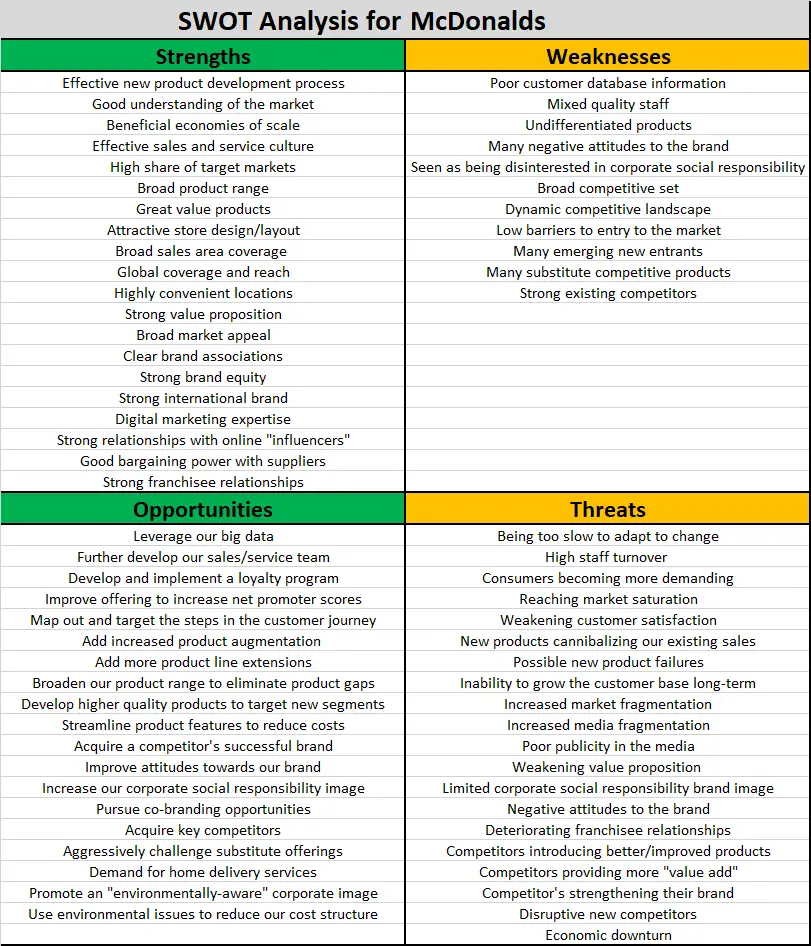Sample SWOT Analysis for McDonald’s Fast Food
Strengths for McDonald’s
| Effective new product development process |
| Good understanding of the market |
| Beneficial economies of scale |
| Effective sales and service culture |
| High share of target markets |
| Broad product range |
| Great value products |
| Attractive store design/layout |
| Broad sales area coverage |
| Global coverage and reach |
| Highly convenient locations |
| Strong value proposition |
| Broad market appeal |
| Clear brand associations |
| Strong brand equity |
| Strong international brand |
| Digital marketing expertise |
| Strong relationships with online “influencers” |
| Good bargaining power with suppliers |
| Strong franchisee relationships |
Weaknesses for McDonald’s
| Poor customer database information |
| Mixed quality staff |
| Undifferentiated products |
| Many negative attitudes to the brand |
| Seen as being disinterested in corporate social responsibility |
| Broad competitive set |
| Dynamic competitive landscape |
| Low barriers to entry to the market |
| Many emerging new entrants |
| Many substitute competitive products |
| Strong existing competitors |
Opportunities for McDonald’s
| Leverage our big data |
| Further develop our sales/service team |
| Develop and implement a loyalty program |
| Improve offering to increase net promoter scores |
| Map out and target the steps in the customer journey |
| Add increased product augmentation |
| Add more product line extensions |
| Broaden our product range to eliminate product gaps |
| Develop higher quality products to target new segments |
| Streamline product features to reduce costs |
| Acquire a competitor’s successful brand |
| Improve attitudes towards our brand |
| Increase our corporate social responsibility image |
| Pursue co-branding opportunities |
| Acquire key competitors |
| Aggressively challenge substitute offerings |
| Demand for home delivery services |
| Promote an “environmentally-aware” corporate image |
| Use environmental issues to reduce our cost structure |
Threats for McDonald’s
| Being too slow to adapt to change |
| High staff turnover |
| Consumers becoming more demanding |
| Reaching market saturation |
| Weakening customer satisfaction |
| New products cannibalizing our existing sales |
| Possible new product failures |
| Inability to grow the customer base long-term |
| Increased market fragmentation |
| Increased media fragmentation |
| Poor publicity in the media |
| Weakening value proposition |
| Limited corporate social responsibility brand image |
| Negative attitudes to the brand |
| Deteriorating franchisee relationships |
| Competitors introducing better/improved products |
| Competitors providing more “value add” |
| Competitor’s strengthening their brand |
| Disruptive new competitors |
| Economic downturn |
Summary SWOT for McDonald’s (image)
McDonald’s Strategic History
Ray Kroc wanted to build a restaurant system that would be famous for providing food of consistently high quality and uniform methods of preparation. He wanted to serve burgers, fries and beverages that tasted just the same in Alaska as they did in Alabama.
To achieve this, he chose a unique path: persuading both franchisees and suppliers to buy into his vision, working not for McDonald’s but for themselves, together with McDonald’s. He promoted the slogan, “In business for yourself, but not by yourself.” His philosophy was based on the simple principle of a 3-legged stool: one leg was McDonald’s franchisees; the second, McDonald’s suppliers; and the third, McDonald’s employees. The stool was only as strong as the three legs that formed its foundation.
“If I had a brick for every time I’ve repeated the phrase Quality, Service, Cleanliness and Value, I think I’d probably be able to bridge the Atlantic Ocean with them.” – Ray Kroc
Source: McDonald’s History

